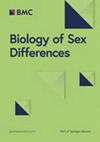Sex and interspecies differences in ESR2-expressing cell distributions in mouse and rat brains
IF 4.9
2区 医学
Q1 ENDOCRINOLOGY & METABOLISM
引用次数: 0
Abstract
ESR2, a nuclear estrogen receptor also known as estrogen receptor β, is expressed in the brain and contributes to the actions of estrogen in various physiological phenomena. However, its expression profiles in the brain have long been debated because of difficulties in detecting ESR2-expressing cells. In the present study, we aimed to determine the distribution of ESR2 in rodent brains, as well as its sex and interspecies differences, using immunohistochemical detection with a well-validated anti-ESR2 antibody (PPZ0506). To determine the expression profiles of ESR2 protein in rodent brains, whole brain sections from mice and rats of both sexes were subjected to immunostaining for ESR2. In addition, to evaluate the effects of circulating estrogen on ESR2 expression profiles, ovariectomized female mice and rats were treated with low or high doses of estrogen, and the resulting numbers of ESR2-immunopositive cells were analyzed. Welch’s t-test was used for comparisons between two groups for sex differences, and one-way analysis of variance followed by the Tukey–Kramer test were used for comparisons among multiple groups with different estrogen treatments. ESR2-immunopositive cells were observed in several subregions of mouse and rat brains, including the preoptic area, extended amygdala, hypothalamus, mesencephalon, and cerebral cortex. Their distribution profiles exhibited sex and interspecies differences. In addition, low-dose estrogen treatment in ovariectomized female mice and rats tended to increase the numbers of ESR2-immunopositive cells, whereas high-dose estrogen treatment tended to decrease these numbers. Immunohistochemistry using the well-validated PPZ0506 antibody revealed a more localized expression of ESR2 protein in rodent brains than has previously been reported. Furthermore, there were marked sex and interspecies differences in its distribution. Our histological analyses also revealed estrogen-dependent changes in ESR2 expression levels in female brains. These findings will be helpful for understanding the ESR2-mediated actions of estrogen in the brain. Although the brain is a major target organ of estrogens, the distribution of estrogen receptors in the brain is not fully understood. ESR2, also known as estrogen receptor β, is an estrogen receptor subtype; its localization in the brain has long been controversial because it has traditionally been difficult to detect. In the present study, we analyzed the expression sites of ESR2 in mouse and rat brains using immunohistochemistry with a well-validated antibody, PPZ0506. The immunohistochemical analysis revealed a more localized expression of ESR2 protein in brain subregions than has previously been reported. Additionally, there were clear sex and interspecies differences in the distribution of this protein. We also observed changes in ESR2 expression in the female brain in response to circulating estrogen levels. Our results, which show the precise expression profiles of ESR2 protein in rodent brains, will be helpful for understanding the ESR2-mediated actions of estrogen.小鼠和大鼠大脑中 ESR2 表达细胞分布的性别和种间差异
ESR2是一种核雌激素受体,也称为雌激素受体β,在大脑中表达,并在各种生理现象中参与雌激素的作用。然而,由于很难检测到 ESR2 表达的细胞,其在大脑中的表达谱长期以来一直存在争议。在本研究中,我们使用一种经过验证的抗 ESR2 抗体(PPZ0506)进行免疫组化检测,旨在确定 ESR2 在啮齿动物大脑中的分布及其性别和种间差异。为了确定 ESR2 蛋白在啮齿类动物大脑中的表达情况,对雌雄小鼠和大鼠的整个大脑切片进行了 ESR2 免疫染色。此外,为了评估循环雌激素对 ESR2 表达谱的影响,用低剂量或高剂量的雌激素处理卵巢切除的雌性小鼠和大鼠,并分析由此产生的 ESR2 免疫阳性细胞的数量。两组间性别差异的比较采用韦尔奇 t 检验,不同雌激素处理的多组间比较采用单因素方差分析和 Tukey-Kramer 检验。在小鼠和大鼠大脑的多个亚区,包括视前区、扩展杏仁核、下丘脑、间脑和大脑皮层,都观察到了ESR2-免疫阳性细胞。它们的分布特征表现出性别和种间差异。此外,对卵巢切除的雌性小鼠和大鼠进行低剂量雌激素治疗后,ESR2-免疫阳性细胞的数量呈上升趋势,而高剂量雌激素治疗则呈下降趋势。使用经过充分验证的 PPZ0506 抗体进行免疫组织化学研究发现,ESR2 蛋白在啮齿类动物大脑中的表达比以前报道的更加局部化。此外,其分布还存在明显的性别和种间差异。我们的组织学分析还揭示了雌性大脑中 ESR2 表达水平的雌激素依赖性变化。这些发现将有助于了解 ESR2 在大脑中介导的雌激素作用。虽然大脑是雌激素的一个主要靶器官,但雌激素受体在大脑中的分布还不完全清楚。ESR2又称雌激素受体β,是雌激素受体的一种亚型;由于传统上很难检测到它,因此它在大脑中的定位一直存在争议。在本研究中,我们用一种有效的抗体 PPZ0506 进行免疫组化,分析了 ESR2 在小鼠和大鼠大脑中的表达位点。免疫组化分析表明,ESR2 蛋白在大脑亚区域的表达比以往报道的更加局部化。此外,该蛋白的分布还存在明显的性别和种间差异。我们还观察到 ESR2 在女性大脑中的表达随循环雌激素水平的变化而变化。我们的研究结果显示了ESR2蛋白在啮齿动物大脑中的精确表达谱,这将有助于理解ESR2介导的雌激素作用。
本文章由计算机程序翻译,如有差异,请以英文原文为准。
求助全文
约1分钟内获得全文
求助全文
来源期刊

Biology of Sex Differences
ENDOCRINOLOGY & METABOLISM-GENETICS & HEREDITY
CiteScore
12.10
自引率
1.30%
发文量
69
审稿时长
14 weeks
期刊介绍:
Biology of Sex Differences is a unique scientific journal focusing on sex differences in physiology, behavior, and disease from molecular to phenotypic levels, incorporating both basic and clinical research. The journal aims to enhance understanding of basic principles and facilitate the development of therapeutic and diagnostic tools specific to sex differences. As an open-access journal, it is the official publication of the Organization for the Study of Sex Differences and co-published by the Society for Women's Health Research.
Topical areas include, but are not limited to sex differences in: genomics; the microbiome; epigenetics; molecular and cell biology; tissue biology; physiology; interaction of tissue systems, in any system including adipose, behavioral, cardiovascular, immune, muscular, neural, renal, and skeletal; clinical studies bearing on sex differences in disease or response to therapy.
 求助内容:
求助内容: 应助结果提醒方式:
应助结果提醒方式:


